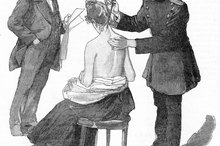Diseases People Had on the Oregon Trail
According to the Idaho State University website, traveling the Oregon Trail involved "walking 2,000 miles barefoot--and that was the easy part." One in 10 people did not survive the Oregon Trail, according to the Oregon-California Trails Association. Injury, disease, and exhaustion were all causes of death on the trail. Water-borne diseases, nutritional diseases, infectious diseases and mosquito-borne diseases all took their toll.
Water-borne Diseases
The majority of diseases on the Oregon Trail are linked to water, according to Northern Arizona University. The most prominent disease was cholera, which comes from drinking contaminated water. Of people who perished on the Trail, cholera claimed a third of them. According to the Oregon Trail's official website, the disease could also be spread when infected bodies were buried in too-shallow graves and subsequently dug up by animals. Usually fatal, the only potentially helpful treatment was laudanum.
Alkali sickness was another common disease on the Oregon Trail. It was caused by drinking water that is too alkaline in its pH. (An example of an extremely alkaline substance would be lye.) On the Trail, the standard treatment was an acidic substance to neutralize it: often, a mixture of vinegar, flour and water.
Dysentery, too, was spread most often by contaminated water. By itself, it was just a particularly painful version of diarrhea, but it could lead to blood poisoning and lethal dehydration. Treatment was limited to rest and fluids.
Nutritional and Dietary Diseases
Swimming While Suffering With the Stomach Flu
Learn More
Because of rotting produce, unpredictable weather, and unreliable hunting conditions, overlanders often had poor nutrition, which led to disease. On the Oregon Trail, the most common dietary disease was scurvy, which comes from a lack of vitamin C in the diet. Consuming vitamin C-rich produce was the best long-term treatment, but since this was often unavailable, travelers often consumed citric acid to prevent scurvy.
Diphtheria was a disease that could be spread by contaminated food. A cold-weather disease, diphtheria was the greatest killer of children along the Oregon Trail. There was no real medical treatment for diphtheria when out on the Trail, and treatment was normally limited to rest and fluids.
Other Diseases
Other diseases were common on the Oregon Trail. Malaria, spread by mosquitoes, could be treated by quinine. Measles, however, another common child-killer, had no real treatment and was often fatal. Smallpox, which also devastated the Native Americans, also took the lives of many travelers, often after contact with infected Native American tribes.









